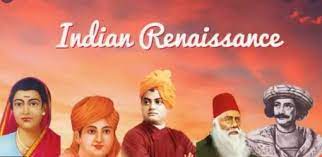Q. What are the main features of Indian Renaissance?
Ans: The Indian Renaissance was a significant cultural, intellectual, and social movement that took place in India during the 19th and early 20th centuries. It marked a period of resurgence in various fields, including literature, art, science, philosophy, and social reform. The Indian Renaissance was characterized by several key features that contributed to the transformation of Indian society and its engagement with modern ideas and values.

Features of the Indian Renaissance
- Intellectual Awakening: The Indian Renaissance was marked by a revival of intellectual curiosity and inquiry. Scholars, writers, and thinkers sought to explore and reinterpret Indian history, culture, and philosophy in light of modern knowledge and scientific thinking.
- Cultural Synthesis: The movement aimed to bridge the gap between traditional Indian culture and the modern world. It sought to integrate the best aspects of both worlds while discarding outdated practices and superstitions.
- Emphasis on Rationality and Science: The Indian Renaissance emphasized the importance of reason, logic, and empirical evidence. It encouraged the study of science, mathematics, and Western thought alongside traditional Indian knowledge.
- Literary and Artistic Revival: The movement saw a resurgence in literature, poetry, and art. Literary giants like Rabindranath Tagore and Bankim Chandra Chattopadhyay emerged during this period, contributing to a new wave of creative expression that blended Indian and Western influences.
- Social and Religious Reforms: The Indian Renaissance prompted critical reevaluation of social norms and religious practices. Reformers like Raja Ram Mohan Roy and Ishwar Chandra Vidyasagar advocated for women’s rights, widow remarriage, abolition of child marriage, and the eradication of social evils.
- Promotion of Education: The movement emphasized the importance of education as a means to empower individuals and society. Educational institutions, both traditional and modern, were established to promote learning and critical thinking.
- Nationalism and Political Awareness: The Indian Renaissance played a crucial role in fostering a sense of nationalism and political consciousness. It provided the intellectual foundation for India’s struggle for independence by promoting ideas of self-determination, social justice, and equality.
- Promotion of Vernacular Languages: The movement encouraged the use of vernacular languages, enabling wider access to literature and knowledge. This contributed to the growth of regional identities and cultural awareness.
- Advocacy for Women’s Rights: The Indian Renaissance marked a significant shift in attitudes toward women’s rights and roles in society. It led to the emergence of women’s organizations and promoted discussions on gender equality and women’s education.
- Impact on Literature and Media: The movement’s ideas and values were reflected in literature, newspapers, magazines, and other forms of media. This helped disseminate new ideas and stimulate public discourse.
- Cross-Cultural Exchange: The Indian Renaissance facilitated cultural exchanges between the East and the West. It encouraged a deeper understanding of Western thought and fostered dialogue between Indian and Western scholars.
In conclusion, the Indian Renaissance was a multifaceted movement that encompassed intellectual, cultural, social, and political aspects. It sought to reconcile India’s rich heritage with the demands of a changing world, while also striving for social reform and the upliftment of society. The impact of the Indian Renaissance is still felt in modern India, shaping its cultural landscape, intellectual pursuits, and social reform efforts.
Thanks for reading the answer to the question: What are the main features of Indian Renaissance?
Read: